今天主要讨论:二叉树相关内容
题目一
实现二叉树的先序、中序、后序遍历,包括递归方式和非递归方式
先序遍历 头左右,右图遍历顺序
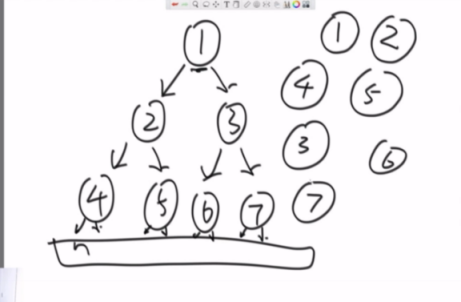
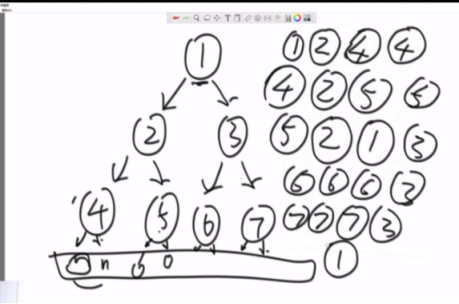
如果打印时机放在第一次来到这个节点的时候,就是先序遍历。
public static void preOrderRecur(Node head) { if (head == null) { return; } System.out.print(head.value + " "); preOrderRecur(head.left); preOrderRecur(head.right); }
如果放在第二次来到这个节点的时候,就是中序遍历。
public static void inOrderRecur(Node head) { if (head == null) { return; } inOrderRecur(head.left); System.out.print(head.value + " "); inOrderRecur(head.right); }
如果把打印时机放在第三次来点这个节点的时候,就是后序遍历。
public static void posOrderRecur(Node head) { if (head == null) { return; } posOrderRecur(head.left); posOrderRecur(head.right); System.out.print(head.value + " "); }
主要是打印时机放在哪里。就被加工出了先序中序后序。
非递归(先序):
中间在最前面,先压right再压left
因为二叉树只能一直往下走,那就要想一个能回去的结构,栈机结构就很合适。

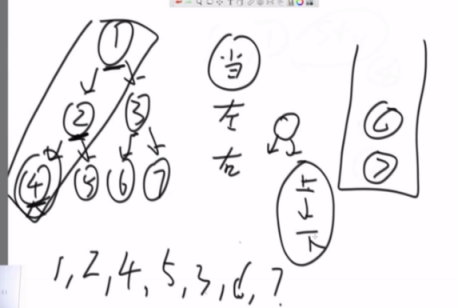
public static void preOrderUnRecur(Node head) { System.out.print("pre-order: "); if (head != null) { Stack<Node> stack = new Stack<Node>(); stack.add(head); while (!stack.isEmpty()) { head = stack.pop(); System.out.print(head.value + " "); if (head.right != null) { stack.push(head.right); } if (head.left != null) { stack.push(head.left); } } } System.out.println(); }
非递归(中序):左中右
整棵树是可以被左边界分解的(弹出顺序是左中)。逆序去处理的过程,实际上可以把整棵树都打印出来。回到2的时候,又把2的右树进行左边界分解,所以你懂得,在分解的时候也不耽误打印整棵树。
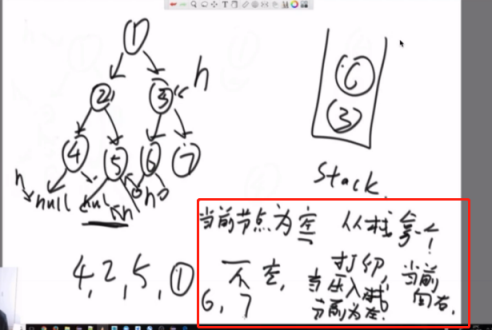

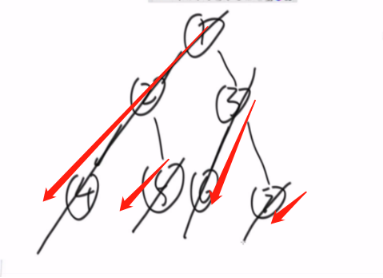
public static void inOrderUnRecur(Node head) { System.out.print("in-order: "); if (head != null) { Stack<Node> stack = new Stack<Node>(); while (!stack.isEmpty() || head != null) { if (head != null) {//当前节点把左边界都压栈 stack.push(head); head = head.left; } else {//当前节点为空,从栈中弹出一个打印 head = stack.pop(); System.out.print(head.value + " "); head = head.right;//向右走 } } } System.out.println(); }
非递归(后序):左右中
递归会返回一个节点三次,而栈会返回两次,后序遍历需要在返回第三次的时候打印。
修改先序遍历,这次先压入左子树,形成中右左,再利用一个辅助栈,把打印结果逆序打印,即是答案。
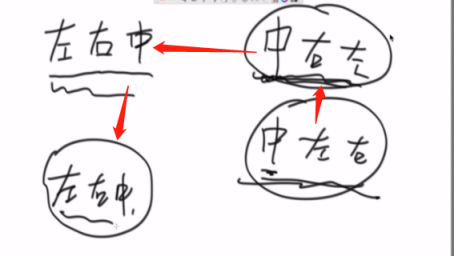
public static void posOrderUnRecur1(Node head) { System.out.print("pos-order: "); if (head != null) { Stack<Node> s1 = new Stack<Node>(); Stack<Node> s2 = new Stack<Node>(); s1.push(head); while (!s1.isEmpty()) { head = s1.pop(); s2.push(head);//本来先序的话是直接输出的,但是这里后序为了左右中输出,就先把中右左存在临时栈中 if (head.left != null) { s1.push(head.left); } if (head.right != null) { s1.push(head.right); } } while (!s2.isEmpty()) { System.out.print(s2.pop().value + " "); } } System.out.println(); }
极客写法:只使用一个栈
public static void posOrderUnRecur2(Node h) { System.out.print("pos-order: "); if (h != null) { Stack<Node> stack = new Stack<Node>(); stack.push(h); Node c = null; while (!stack.isEmpty()) { c = stack.peek(); if (c.left != null && h != c.left && h != c.right) { stack.push(c.left); } else if (c.right != null && h != c.right) { stack.push(c.right); } else { System.out.print(stack.pop().value + " "); h = c; } } } System.out.println(); }
题目二
如何直观的打印一颗二叉树
一个福利函数,用于调试二叉树。
H1H表示1是头结点,v66v是向下指的,他的父节点是左下方离他最近的
^555555^是向上指的,父节点为左上距离最近的。
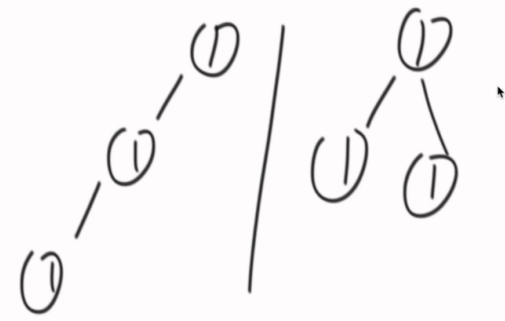

public class Code_02_PrintBinaryTree { public static class Node { public int value; public Node left; public Node right; public Node(int data) { this.value = data; } } public static void printTree(Node head) { System.out.println("Binary Tree:"); printInOrder(head, 0, "H", 17); System.out.println(); } public static void printInOrder(Node head, int height, String to, int len) { if (head == null) { return; } printInOrder(head.right, height + 1, "v", len); String val = to + head.value + to; int lenM = val.length(); int lenL = (len - lenM) / 2; int lenR = len - lenM - lenL; val = getSpace(lenL) + val + getSpace(lenR); System.out.println(getSpace(height * len) + val); printInOrder(head.left, height + 1, "^", len); } public static String getSpace(int num) { String space = " "; StringBuffer buf = new StringBuffer(""); for (int i = 0; i < num; i++) { buf.append(space); } return buf.toString(); } public static void main(String[] args) { Node head = new Node(1); head.left = new Node(-222222222); head.right = new Node(3); head.left.left = new Node(Integer.MIN_VALUE); head.right.left = new Node(55555555); head.right.right = new Node(66); head.left.left.right = new Node(777); printTree(head); head = new Node(1); head.left = new Node(2); head.right = new Node(3); head.left.left = new Node(4); head.right.left = new Node(5); head.right.right = new Node(6); head.left.left.right = new Node(7); printTree(head); head = new Node(1); head.left = new Node(1); head.right = new Node(1); head.left.left = new Node(1); head.right.left = new Node(1); head.right.right = new Node(1); head.left.left.right = new Node(1); printTree(head); } }
题目三
在二叉树中找到一个节点的后继节点
【题目】 现在有一种新的二叉树节点类型如下:
public class Node { public int value; public Node left; public Node right; public Node parent; public Node(int data) { this.value = data; } }
该结构比普通二叉树节点结构多了一个指向父节点的parent指针。假设有一棵Node类型的节点组成的二叉树,树中每个节点的parent指针都正确地指向自己的父节点,头节点的parent指向null。只给一个在二叉树中的某个节点 node,请实现返回node的后继节点的函数。
在二叉树的中序遍历的序列中,node的下一个节点叫作node的后继节点。
中序遍历的顺序。(前继和后继节点)

怎么避免遍历整棵树,也能找到后继节点?
规律:x节点,如果有右子树,那么他的后继节点是右子树上最左的节点。(根据遍历顺序左中右,右子树后下一个遍历的就是左)

当x没有右子树,要找哪一个结点的左子树是以x结尾的。
通过x的父指针找到父结点,如果发现x是右孩子,就继续往上,一直到某一节点,是他父结点的左孩子,停止。(注意最右边的7找到的是null,代码层面要做相应的判断)


public class Code_03_SuccessorNode { public static class Node { public int value; public Node left; public Node right; public Node parent; public Node(int data) { this.value = data; } } public static Node getSuccessorNode(Node node) { if (node == null) { return node; } if (node.right != null) {//如果有右子树 return getLeftMost(node.right); } else {//如果没有右子树 Node parent = node.parent; while (parent != null && parent.left != node) { node = parent; parent = node.parent; } return parent; } } //获得最左边的节点 public static Node getLeftMost(Node node) { if (node == null) { return node; } while (node.left != null) { node = node.left; } return node; } public static void main(String[] args) { Node head = new Node(6); head.parent = null; head.left = new Node(3); head.left.parent = head; head.left.left = new Node(1); head.left.left.parent = head.left; head.left.left.right = new Node(2); head.left.left.right.parent = head.left.left; head.left.right = new Node(4); head.left.right.parent = head.left; head.left.right.right = new Node(5); head.left.right.right.parent = head.left.right; head.right = new Node(9); head.right.parent = head; head.right.left = new Node(8); head.right.left.parent = head.right; head.right.left.left = new Node(7); head.right.left.left.parent = head.right.left; head.right.right = new Node(10); head.right.right.parent = head.right; Node test = head.left.left; System.out.println(test.value + " next: " + getSuccessorNode(test).value); test = head.left.left.right; System.out.println(test.value + " next: " + getSuccessorNode(test).value); test = head.left; System.out.println(test.value + " next: " + getSuccessorNode(test).value); test = head.left.right; System.out.println(test.value + " next: " + getSuccessorNode(test).value); test = head.left.right.right; System.out.println(test.value + " next: " + getSuccessorNode(test).value); test = head; System.out.println(test.value + " next: " + getSuccessorNode(test).value); test = head.right.left.left; System.out.println(test.value + " next: " + getSuccessorNode(test).value); test = head.right.left; System.out.println(test.value + " next: " + getSuccessorNode(test).value); test = head.right; System.out.println(test.value + " next: " + getSuccessorNode(test).value); test = head.right.right; // 10's next is null System.out.println(test.value + " next: " + getSuccessorNode(test)); } }
前驱怎么找?
x如果有左子树,就是左子树最右的节点。
如果x没有左子树,往上找,找到一个父结点的右孩子,是当前节点就停。
public static Node getPrecursorNode(Node node){ if (node == null) { return node; } if(node.left != null){ return getRightMost(node); }else{ Node parent = node.parent; while(parent!=null&& parent.right!=node){ node = parent; parent = node.parent; } return parent; } } //获得最右边的节点 public static Node getRightMost(Node node) { if (node == null) { return node; } while (node.right != null) { node = node.right; } return node; }
面试流程
一般亚马逊、谷歌、微软公司,4~5面。
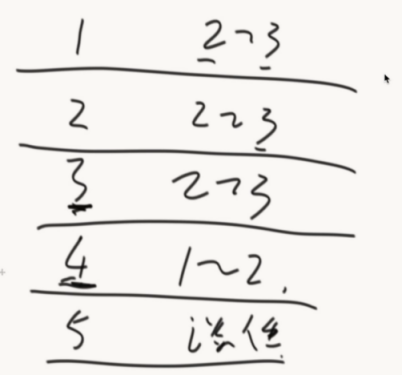
要达到,面试官准备给你的题库全彻底完成。
3面4面就是技术面了,比方说设计一个系统停车场系统、图书馆系统
如果题目做完,需要问问面试官还有没有题目。万无一失
题目四
介绍二叉树的序列化和反序列化
怎么把信息保存成文件形式,以确保下次可以重建一棵树。
第一种:先序的方式序列化,树怎么变字符串,#表示遇到空
需要#和_是因为能更好的表示一些特殊的结构。
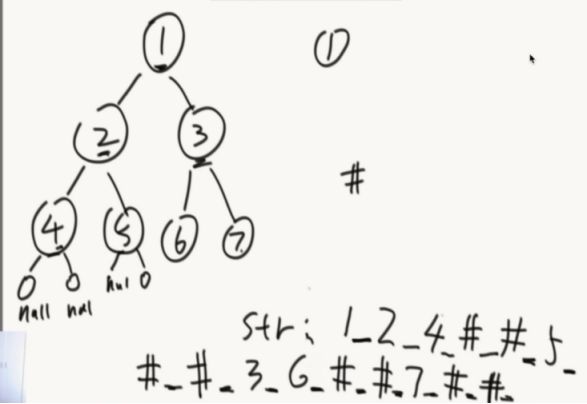
留下划线的原因是为了识别以下的树形结构:


public static String serialByPre(Node head) { if (head == null) { return "#_"; } String res = head.value + "_"; res += serialByPre(head.left); res += serialByPre(head.right); return res; }
怎么反序列化:怎么序列化的就怎么反序列化
利用_分隔,获得就是每一个节点,利用先序遍历的方式,反序列化
按照中左右的方式,依次建立。碰到空就不为空建立子树,返回父节点建立其他子树。(中序、后序同理)
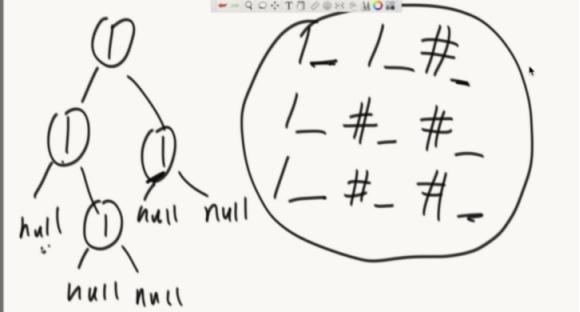
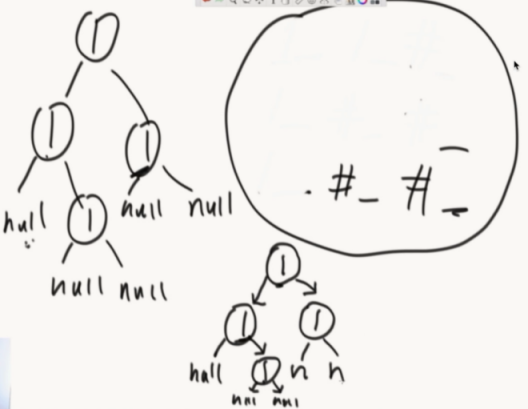
public static Node reconByPreString(String preStr) { String[] values = preStr.split("_"); Queue<String> queue = new LinkedList<String>(); //加入到队列中 for (int i = 0; i != values.length; i++) { queue.offer(values[i]); } return reconPreOrder(queue); } public static Node reconPreOrder(Queue<String> queue) { String value = queue.poll(); if (value.equals("#")) { return null; } //中左右 Node head = new Node(Integer.valueOf(value)); head.left = reconPreOrder(queue); head.right = reconPreOrder(queue); return head; }
OJ测试就是通过把你的二叉树序列化,再和正确答案比对来判断是否正确的。牛客网就是按照层来序列化。
按层序列化同理:
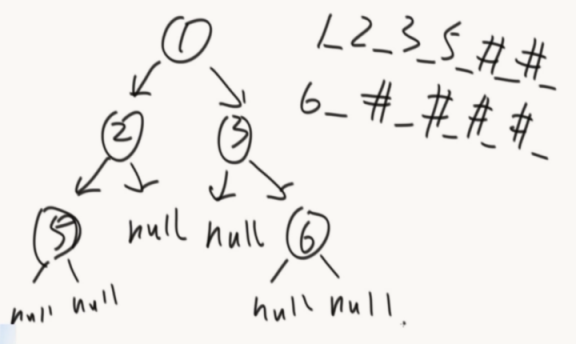
public static String serialByLevel(Node head) { if (head == null) { return "#_"; } String res = head.value + "_"; Queue<Node> queue = new LinkedList<Node>(); queue.offer(head); while (!queue.isEmpty()) { head = queue.poll(); if (head.left != null) { res += head.left.value + "_"; queue.offer(head.left); } else { res += "#_"; } if (head.right != null) { res += head.right.value + "_"; queue.offer(head.right); } else { res += "#_"; } } return res; } public static Node reconByLevelString(String levelStr) { String[] values = levelStr.split("_"); int index = 0; Node head = generateNodeByString(values[index++]); Queue<Node> queue = new LinkedList<Node>(); if (head != null) { queue.offer(head); } Node node = null; while (!queue.isEmpty()) { node = queue.poll(); node.left = generateNodeByString(values[index++]); node.right = generateNodeByString(values[index++]); if (node.left != null) { queue.offer(node.left); } if (node.right != null) { queue.offer(node.right); } } return head; } public static Node generateNodeByString(String val) { if (val.equals("#")) { return null; } return new Node(Integer.valueOf(val)); }
题目五
折纸问题(福利课讲的)
【题目】 请把一段纸条竖着放在桌子上,然后从纸条的下边向上方对折1次,压出折痕后展开。此时 折痕是凹下去的,即折痕突起的方向指向纸条的背面。如果从纸条的下边向上方连续对折2 次,压出折痕后展开,此时有三条折痕,从上到下依次是下折痕、下折痕和上折痕。
给定一 个输入参数N,代表纸条都从下边向上方连续对折N次,请从上到下打印所有折痕的方向。 例如:N=1时,打印: down N=2时,打印: down down up
参考:https://blog.csdn.net/zhou_209/article/details/79437262
题目六
判断一棵二叉树是否是平衡二叉树
在树中任何一个节点,它左子树和右子树的高度差不超过一,这叫平衡二叉树。抛出一个套路:递归函数很好用,可以回到一个三次。
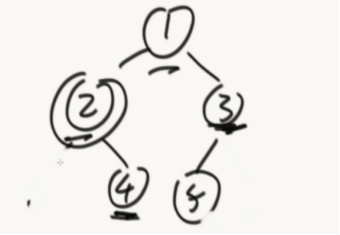
四个信息:左/右是否平衡、左/右的高
所以经过分析每颗子树应该返回,是否平衡和树高的信息。
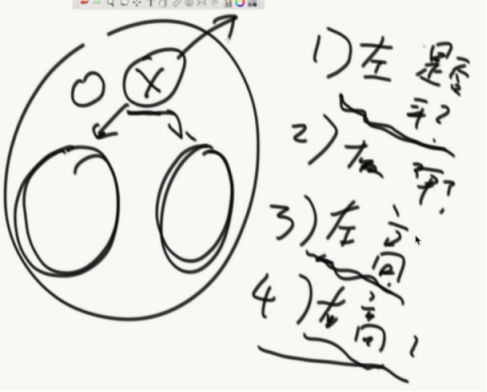
下面就是码代码阶段:
难度在于要列出可能性。写代码的过程高度套路化。
列出可能性、整理出返回值的类型、整个递归过程按照同样的结构、得到子树的信息、整合子树的信息、加工出我的信息、往上返回、要求结构完全一致,因为是递归函数。

public static class ReturnData{ public boolean isBalance; public int level; public ReturnData(boolean isBalance, int level) { this.isBalance = isBalance; this.level = level; } } public static ReturnData process(Node head){ if(head == null){ return new ReturnData(true,0); } //如果左子树或者右子树返回了他们不是平衡的,那总体也不会是平衡的 ReturnData lRData = process(head.left); if(!lRData.isBalance){ return new ReturnData(true,0); } ReturnData rRData = process(head.right); if(!rRData.isBalance){ return new ReturnData(true,0); } if(Math.abs(lRData.level - rRData.level) > 1){ return new ReturnData(true,0); } return new ReturnData(true,Math.max(lRData.level,rRData.level)+1); }
你就想我们会遍历每个节点,我考虑以每个节点为头的整棵树,怎么怎么样都判断完,那么我整个答案就出来了。
这个大套路,整个方法论就这个过程。
左树收集什么信息,右树收集什么信息,列出可能性,这是你要去想的。
高度怎么变化的?

public class Code_06_IsBalancedTree { public static class Node { ... } public static boolean isBalance(Node head) { boolean[] res = new boolean[1]; res[0] = true; getHeight(head, 1, res); return res[0]; } public static int getHeight(Node head, int level, boolean[] res) { if (head == null) { return level; } int lH = getHeight(head.left, level + 1, res); if (!res[0]) { return level; } int rH = getHeight(head.right, level + 1, res); if (!res[0]) { return level; } if (Math.abs(lH - rH) > 1) { res[0] = false; } return Math.max(lH, rH); } public static void main(String[] args) { Node head = new Node(1); head.left = new Node(2); head.right = new Node(3); head.left.left = new Node(4); head.left.right = new Node(5); head.right.left = new Node(6); head.right.right = new Node(7); System.out.println(isBalance(head)); } }
具体想进阶参考:树形DP
平衡二叉树用于解决效率的问题。
题目七
判断一棵树是否是搜索二叉树、判断一棵树是否是完全二叉树
搜索二叉树:左子树比他小,右子树比他大
中序遍历依次升序的就是。(通常来讲不出现重复节点,重复的话可以压缩在同一个list里面)
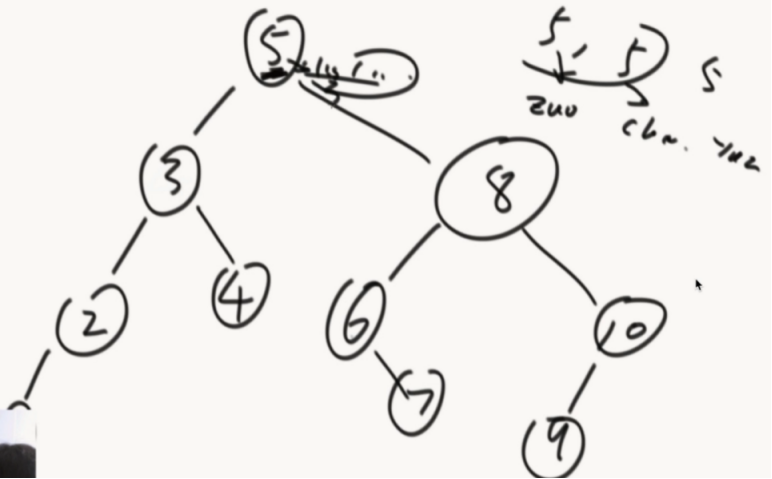
代码实现通过修改非递归的中序遍历来判断(对比之前的数和显示的数是否呈现出升序)(递归版怎么改?难度比较大)
public static boolean isBST(Node head) { if (head == null) { return true; } Stack<Node> stack = new Stack<Node>(); //首先有一个很小的数做初始值 int flag = Integer.MIN_VALUE; while (!stack.isEmpty() || head != null) { if (head != null) { stack.push(head); head = head.left; } else { head = stack.pop(); if (head.value < flag) { return false;//不是升序就不是搜索二叉树 } head = head.right; } } return true; }
//Morris遍历版本 //左子树小、右子树大 public static boolean isBST(Node head) { if (head == null) { return true; } boolean res = true; Node pre = null; Node cur1 = head; Node cur2 = null; while (cur1 != null) { cur2 = cur1.left; if (cur2 != null) { while (cur2.right != null && cur2.right != cur1) { cur2 = cur2.right; } if (cur2.right == null) { cur2.right = cur1; cur1 = cur1.left; continue; } else { cur2.right = null; } } if (pre != null && pre.value > cur1.value) { res = false; } pre = cur1; cur1 = cur1.right; } return res; }
完全二叉树怎么判断?
按层遍历,以下条件按照顺序判断
1、如果一个子树有右孩子没左孩子肯定不是完二叉。返回false
2、如果一个节点,不是左右孩子都全,出现这种情况,他后面出现的节点,都必须是叶子节点,否则false。
State状态一开始是false,遇到二的情况变true,遇到后续节点不是叶子节点就直接返回false
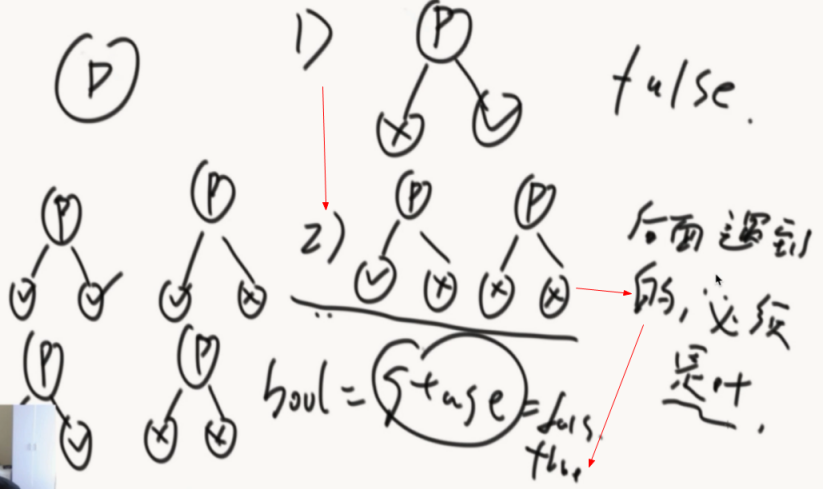
节点5中了第二种情况,接下来的都要是叶子节点。
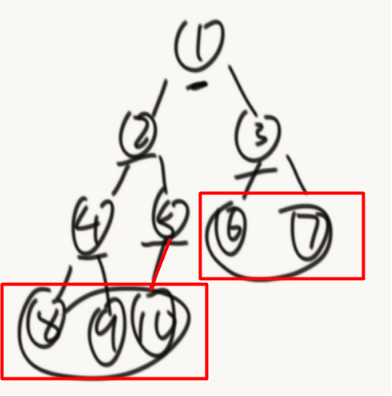
public static boolean isCBT(Node head) { if (head == null) { return true; } Queue<Node> queue = new LinkedList<Node>(); boolean leaf = false; Node l = null; Node r = null; queue.offer(head); while (!queue.isEmpty()) { head = queue.poll(); l = head.left; r = head.right; if ((leaf && (l != null || r != null)) || (l == null && r != null)) { return false; } if (l != null) { queue.offer(l); } if (r != null) { queue.offer(r); } else {//如果右子树为空,左子树不为空,接下来的都要是叶子节点 leaf = true; } } return true; }
DQ和Q都可以使用双端链表来实现。(Java中的LinkedList底层实现)
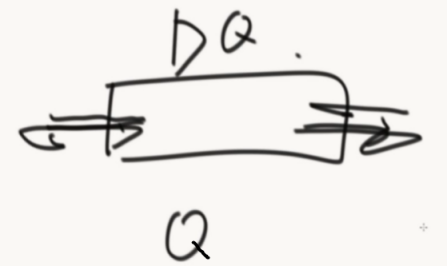
题目八
已知一棵完全二叉树,求其节点的个数
要求:时间复杂度低于O(N),N为这棵树的节点个数
先遍历左边界,获得层高。然后遍历右子树的左边界,如果等于总的左边界的层高,就证明,左子树是满二叉树。
然后通过公式计算出左子树的个数,再递归处理右子树。
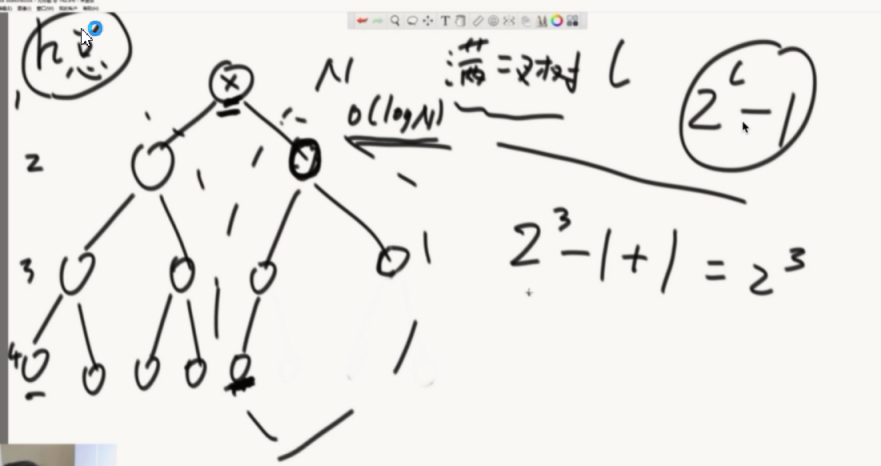
如果右子树的左边界没到最后一层。那就证明,右子树是左树高度-1的满二叉树。然后再递归处理左树。
所以每次拿到一个节点,就判断右树的左边界是否到最后一层,到了左树就是满的,没到右树就是满的,只不过左树和右树满的高度不一样而已,都可以使用公式来计算。剩下的节点递归去求。
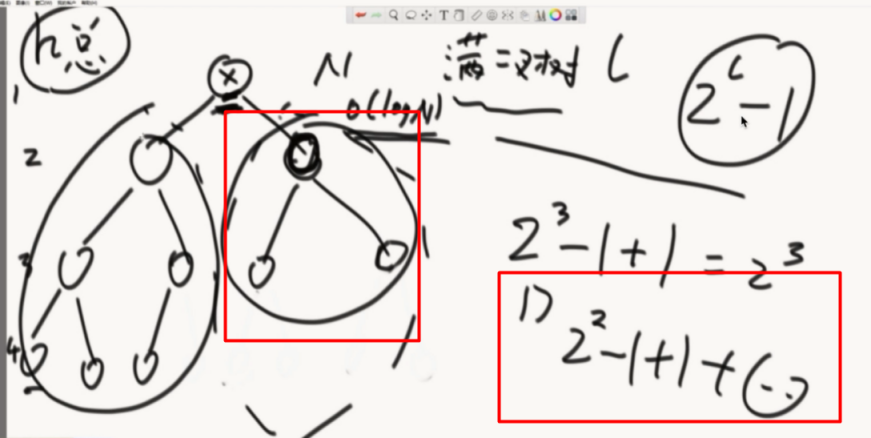
代码解说:
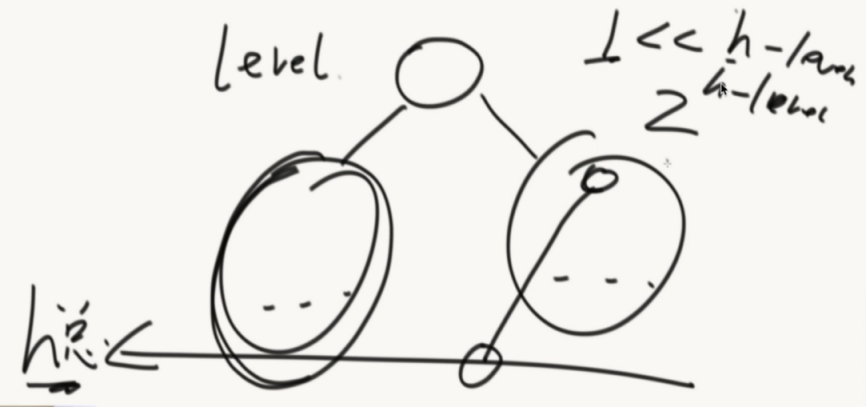
public class Code_08_CompleteTreeNodeNumber { public static class Node { ... } public static int nodeNum(Node head) { if (head == null) { return 0; } return bs(head, 1, mostLeftLevel(head, 1)); } //当前节点、节点在第几层、整棵树的树高 public static int bs(Node node, int level, int h) { if (level == h) {//如果level来到最后一层,就是叶子节点 return 1; } if (mostLeftLevel(node.right, level + 1) == h) { return (1 << (h - level)) + bs(node.right, level + 1, h); } else { return (1 << (h - level - 1)) + bs(node.left, level + 1, h); } } public static int mostLeftLevel(Node node, int level) { while (node != null) { level++; node = node.left; } return level - 1; } public static void main(String[] args) { Node head = new Node(1); head.left = new Node(2); head.right = new Node(3); head.left.left = new Node(4); head.left.right = new Node(5); head.right.left = new Node(6); System.out.println(nodeNum(head)); } }
算法复杂度:
遍历节点 logN 获得左边界 LogN LogN²
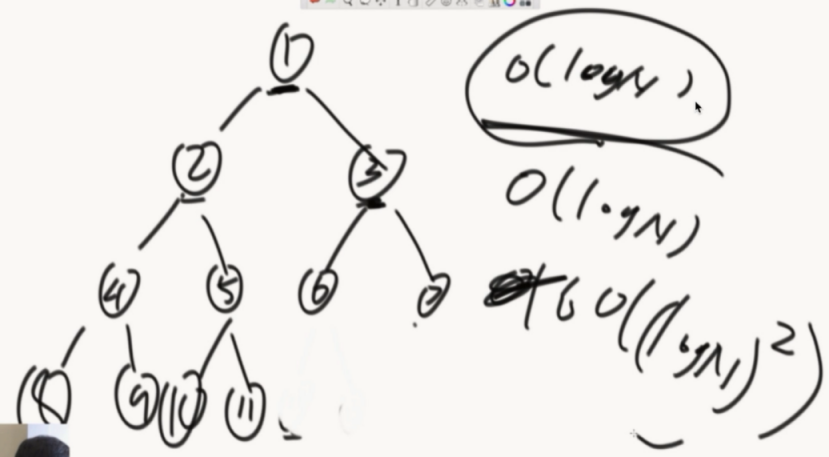
//当前节点把左边界都压栈